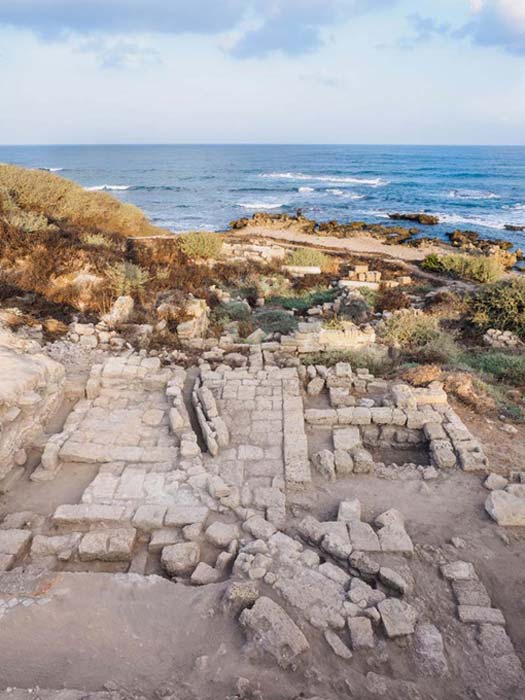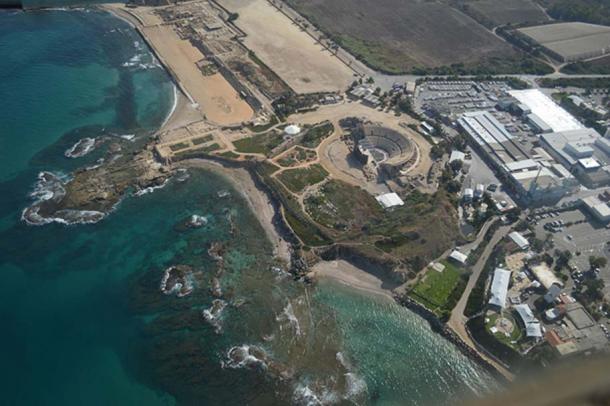What New Archaeological Treasures Have Been Unearthed in the Ancient City of Caesarea?
This week, Caesarea National Park came a step closer to its goal of rivaling Jerusalem as the top tourist destination in Israel. After a $27.5 million investment plan from the Edmond de Rothschild Foundation last year, the upgrading project is well underway.
12 months of excavation and reconstruction with the cooperation and further investment from the Israel Antiquities Authority and the Israel Nature and Parks Authority has resulted in the first phase being unveiled to the public.
A 700-year-old Crusader market at the Caesarea Harbor and promenade walls were opened on June 10, with Baroness Ariane de Rothschild and other representatives in attendance.
Dr. Peter Gendelman, senior archaeologist at the Israel Antiquities Authority (IAA) and head of the Caesarea excavations told Breaking Israel News:
“This is one of the largest and most amazing archaeological sites in Israel if not in the whole eastern Mediterranean, including the discovery two years ago of the foundation of the high altar of the temple that King Herod built in Caesarea.”
Through the centuries, Caesarea’s populace comprised all the major Abrahamic faiths—Judaism, Christianity, and Islam. Throw in the original religion at the site, paganism, and you will get an idea of the importance of Caesarea, where major restoration projects are underway.
Archaeologists working in Caesarea found an ancient mother-of-pearl tablet incised with a menorah. The menorah tablet dates to the 4th or 5th century AD, experts have estimated. Other recent activity at the site includes preservation of an ancient synagogue and aqueduct. They also found an altar used to worship Caesar Augustus.

Experts say the mother-of-pearl tablet with the menorah found in the ancient harbor town of Caesarea is evidence of a Jewish presence from the 4th or 5th centuries AD. (Clara Amit/Israel Antiquities Authority)
Roman dictators fancied themselves deities and ordered their worship across the empire. Julius Caesar’s family said they were descended from Roman forefather Aeneas and the goddess of love and war, Venus. Augustus, Julius’ grand-nephew who became emperor, added Divi Filius, “son of the divine,” to his name. Augustus ruled the Roman Empire from 27 BC to 14 AD.
- Divers find largest golden coin hoard ever discovered in Israel
- 1600-Year-Old Cargo of a Roman Merchant Ship has been Discovered in Caesarea
The Israel Antiquities Authority calls the excavations and conservation projects at Caesarea, underway for many years, some of the largest and most important ever done in Israel.

The ancient synagogue of Caesarea. (Assaf Peretz/ Israel Antiquities Authority)
Phys.org said in a report about the recent finds: “The site, which contains ruins from later periods including the Byzantine, Muslim and Crusader eras, has been the focus of major excavation work over the decades but recent work has revealed new secrets.”
Herod the Great, the king of Judea appointed by Rome, founded Caesarea. Herod has an interesting background. Herod’s father and mother were Arab but practiced Judaism. Herod’s father, Antipater, was a friend of Julius Caesar, who appointed him procurator (governor) of Judea in 47 BC.
Antipater appointed Herod the governor of Galilee, a province of Judea. Mark Antony later appointed him tetrarch of Galilee. When the Parthians invaded Palestine in 40 BC, Herod fled to Rome, where the Senate nominated him king of Judea. They also gave him an army to secure his throne, which he did in 37 BC.

Aerial photo of Caesarea Maritima. (Meronim/CC BY SA 3.0)
A book excerpt about Caesarea Maritima on the Cornell University website states:
“Caesarea Maritima, established by Herod the Great on the site of the Hellenistic city of Strato's Tower, has been known continuously from its founding through until the present day, and is the setting for numerous historically significant events and personages. The palace of the city is mentioned in only a few instances, although incidents in lives of the procurators, governors and other officials who dwelt there are more frequently described.”

Harbor Scene with St. Paul's Departure from Caesarea, by Jan Brueghel the Elder (Public Domain)
An archaeologist who is part of the team working at the site, Peter Gendelman, led Phys.org on a tour of Caesarea and called the preservation work there the most complicated and interesting that he’s done in his 30 years as an archaeologist.
Dr. Gendelman told Phys.org that recent discoveries there are changing researchers’ “understanding of the dynamics of this area.”
- Lifestyles of the rich and famous in biblical times
- Mythbusting Ancient Rome – Throwing Christians to the Lions

Part of an ancient Greek inscription found during excavations at Caesarea in April 2017. (Ilan Ben Zion/Times of Israel)
Phys.org also quoted Guy Swersky of the Rothschild Caesarea Foundation as saying, “This was by far the most important port city in this area of the Middle East.”
The Israeli government and the Rothschilds have allotted $27 million (25 million Euros) for the exploration and conservation of the site.
Archaeologists intend to continue excavating and preserving the site and open a visitor’s center that will explain the history of Caesarea.
The site already draws visitors to the ruins of an amphitheater that has been restored somewhat to play host to concerts. Israeli officials hope to draw 3 million visitors annually to the site and its beaches by 2030.
Top image: Statue of a ram that was discovered next to the vaults at the front of the temple platform in Caesarea. The town was founded by Herod the Great, king of Judea under the Roman Empire. Source: Caesarea Development Corporation
By Mark Miller


















Comments
You should also include information on the destruction of a historic Muslim cemetery. According to articles in Sputnik, this park project is building a nature walk through the cemetery and destroying ancient graves and closing off 40 percent of the cemetery. The history of Palestine is a long one and it is not the sole province of the Jewish faith.